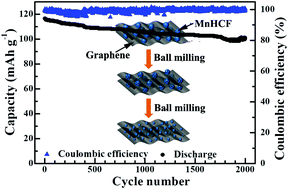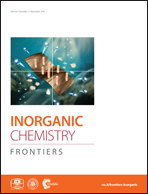Manganese hexacyanoferrate/graphene cathodes for sodium-ion batteries with superior rate capability and ultralong cycle life†
Abstract
Although Prussian blue analogues (PBAs) show promising potential applications as cathodes for sodium ion batteries, great challenges still remain to develop high-performance PBAs. In this work, we report the synthesis of high-performance manganese hexacyanoferrate/graphene (MnHCF/G) nanocomposites using a facile ball-milling route. It was found that after the ball-milling process, the MnHCF nanoparticles were pulverized into smaller grains that were uniformly anchored onto the few-layered graphene nanosheets. The product exhibits high capacity (142.7 mA h g−1 at 0.1C), high working voltage (∼3.7 V at 0.1C), superior rate capability (115.8 mA h g−1 at 10C and 89.7 mA h g−1 at 20C) and long cycle life (90.6% after 500 cycles at 1C, 91.8% after 1700 cycles at 5C, and 86.0% after 2000 cycles at 10C). The excellent electrochemical performance of MnHCF/G is ascribed to the small size of MnHCF and the conductive and protective effects of graphene. This work provides a practical method to synthesize high-performance PBA-based materials for sodium-ion batteries.



 Please wait while we load your content...
Please wait while we load your content...